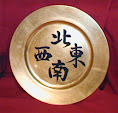Initiative
The chapter starts with a long explanation as to how Dragonbane manages Initiative, which makes sense since it is quite idiosyncratic. Each player, and the GM who manages all the NPCs/monsters involved in the combat, draws a card from a deck containing 10 cards numbered 1−10. The card will indicate the drawer’s turn in the combat round (lowest goes first). At the beginning of the next round, everyone draws a card again. Obviously, the GM may decide to draw several cards instead of a single one, especially if there is a ‘boss’ and their ‘mooks’, or different kinds of opponents (humanoids and monsters, for instance).
A few spot rules allow the GM to factor in further elements like surprise, delaying one’s attack, etc.
Actions & Reactions
During their turn in a given combat round, each combatant may move and act (one move and one action, in any order). Parrying or dodging uses up one’s movement and action for the combat round, meaning you must carefully plan whether you attack or keep your action for later on if you’re fighting a particular dangerous opponent or if you do not have many HPs left. I’m not particularly fond of this rule, but obviously since I’ve never played Dragonbane I’d have to run a few sample encounters to form an opinion. I also suspect that player co-ordination is much more important in Dragonbane than in BRP/RuneQuest.
Casting a spell, using a noncombat skill/heroic ability, or helping another character all also count as one action. Disengaging from an opponent doesn’t count as an action but will give your opponent a free attack, which cannot be parried or dodged, if the relevant skill roll is failed.
Mêlée Combat
The various details of mêlée combat are quite similar to what you’d expect in a BRP-powered game. The main improvement, I think, is that a lot of peculiarities that would entail percentage modifications in BRP/RuneQuest are simply (and elegantly) managed by the bane/boon system in Dragonbane.
As mentioned in yesterday’s post, rolling a 1 is a critical, and rolling a 20 is a fumble, period.
If you roll a critical, instead of starting a string of complex calculations based on the kind of damage the weapon inflicts (crushing/impaling/slashing), as in RuneQuest, you simply choose an outcome out of three possible ones:
1. Double weapon’s damage (before applying damage bonus)
2. Immediately perform a free second attack against another opponent
3. Ignore opponent’s armour
If you roll a fumble, you roll 1D6 and check the fumble table. The results are quite similar to the ones in the BRP/RuneQuest fumble tables, with less variety.
The effects of a critical parry are different than in BRP/RuneQuest.
Ranged Combat
Most of what I’ve written above also applies to ranged combat. In case of a critical, only effects No.1 and No.3 may be chosen.
Parrying a ranged attack is possible, but only with a shield.
If a target is partially covered, the attacker gets a bane.
Damage, Death & Healing
Alas, Dragonbane doesn’t use hit locations (of which I’m very fond). As a result, armour provides the same protection on the whole body; wearing a helmet simply adds further protection.
Dragonbane manages weapon durability in a much simpler way than BRP/RuneQuest: a weapon is either intact or damaged; you do not tally the weapon’s hit points.
Again, since Dragonbane doesn’t use hit locations, only the total hit points of your character will determine their state. Once the PC’s HPs reach 0, you start rolling against your CON each round and must tally successes and failures. After three successes, you recover 1D6 HPs; after three failures, the character is dead.
Surviving death, however, yields after-effects (you roll on a table) that take between 1 and 18 days to heal. Some after-effects (teeth knocked out, a severed finger) are permanent.
On top of magical healing, Dragonbane PCs may recover lost hit points via a stretch rest (1D6 to 2D6) or a shift rest (all HPs). I hate this… it smacks so much of D&D: “Oh, I got hit by a sword and I have this huge gash in my abdomen. No worries, a good night’s sleep and it will be forgotten!”
Spot Rules
This chapter also provides spot rules for Darkness combat, Disease, Drowning, Falling, Fear, Improvised weapons, Mounted Combat, Poison. These are all well thought out.













It looks like you wouldn't 100% enjoy playing this game, but you would enjoy using some of its rules. Are you planning to running or playing a game?
ReplyDeleteI’m 99% enthusiastic about the rules. I feel they’re probably the best iteration of BRP ever, as I feel they are fantastically streamlined and reduced to what is really necessary to run an frp game using the Chaosium engine.
DeleteWhat is dislike is mostly the implied D&D-ish setting and its failures. I may have been emphasising my dislikes too much compared with what I am enjoying by reading through the rules.